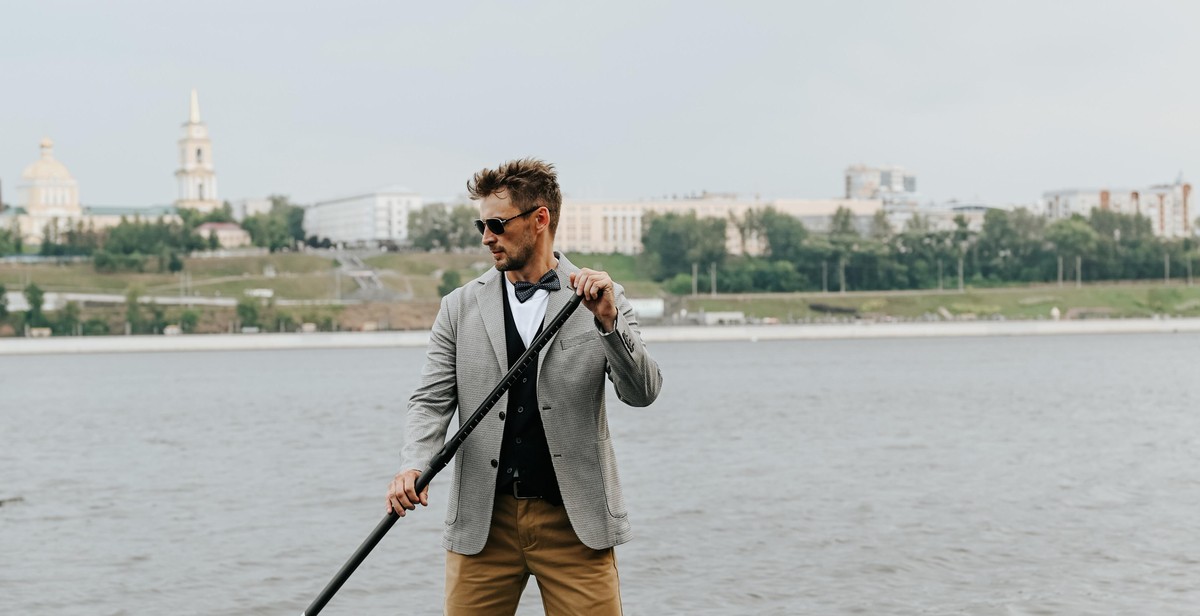How to Safely Explore a Lake on a Stand-Up Paddleboard (SUP): Essential Tips for Beginners
Stand-up paddleboarding (SUP) is a fun and exciting way to explore lakes and other bodies of water. It’s a great workout that engages your core muscles and improves your balance. However, it’s important to take the necessary precautions to ensure your safety while out on the water.
Choose the Right Equipment
Before heading out on your SUP adventure, make sure you have the right equipment. This includes a high-quality paddleboard, paddle, and personal flotation device (PFD). It’s important to choose a board that is appropriate for your skill level and the conditions of the lake you’ll be exploring.
Check the Weather Conditions
Before heading out on the water, check the weather forecast. Avoid going out in high winds, thunderstorms, or other dangerous weather conditions. It’s also a good idea to check the water temperature and wear appropriate clothing to stay warm.
Learn Proper Technique
Proper technique is essential to safely and effectively paddleboard. Take a lesson or watch instructional videos to learn the correct posture, stroke, and how to turn the board. Practice in calm waters before attempting to paddle in more challenging conditions.
Stay Aware of Your Surroundings
Always be aware of your surroundings while paddleboarding. Look out for other boats, swimmers, and obstacles in the water. Avoid crowded areas and stay away from areas with strong currents or dangerous wildlife.
Conclusion
By following these essential tips, beginners can safely explore a lake on a stand-up paddleboard. Remember to choose the right equipment, check the weather conditions, learn proper technique, and stay aware of your surroundings. With these precautions, you can enjoy a fun and safe SUP adventure.
Choosing the Right Equipment
Before you hit the water on a stand-up paddleboard, it’s important to choose the right equipment. This will ensure that you have a safe and enjoyable experience on the lake. Here are some tips for selecting the right equipment:
Selecting the Right Board
The first step in choosing the right stand-up paddleboard is to consider your experience level. If you’re a beginner, look for a board that is wider and more stable. This will help you maintain your balance as you learn to paddle. Experienced paddlers may prefer a narrower board for increased speed and maneuverability.
You should also consider the size and weight of the board. A larger board will be more stable but also heavier and harder to maneuver. A smaller board will be more agile but less stable. Think about your physical capabilities and the type of paddling you plan to do when selecting the size and weight of your board.
Choosing the Right Paddle
The right paddle is just as important as the right board. When selecting a paddle, consider the length, weight, and material. The length of the paddle should be based on your height and the type of paddling you plan to do. A heavier paddle may be more durable but also harder to maneuver. Look for a lightweight paddle made from carbon fiber or fiberglass for increased performance.
Selecting the Right Personal Flotation Device (PFD)
A personal flotation device (PFD) is essential for safety on the water. Look for a PFD that is approved by the U.S. Coast Guard and fits properly. The PFD should be snug but not too tight and allow for a full range of motion. Choose a PFD based on your weight and the type of paddling you plan to do.
| Equipment | Considerations |
|---|---|
| Stand-up Paddleboard | – Experience level – Size and weight |
| Paddle | – Length – Weight – Material |
| Personal Flotation Device (PFD) | – U.S. Coast Guard approved – Proper fit – Weight |

Safety Tips on the Water
Exploring a lake on a stand-up paddleboard (SUP) can be a fun and exciting experience, but it’s important to prioritize safety. Here are some essential tips for beginners:
Check the Weather and Water Conditions
Before you hit the water, make sure to check the weather forecast and water conditions. Avoid paddling in strong winds, thunderstorms, or rough waters. If you’re not sure about the conditions, it’s best to wait for another day.
Wear Sun Protection
Spending time on the water means exposure to the sun’s harmful rays. Wear a hat, sunglasses, and apply waterproof sunscreen with at least SPF 30 to protect your skin from sunburn and potential skin damage.
Stay Hydrated
Bring plenty of water with you and take regular breaks to hydrate. Paddling can be a strenuous activity, and it’s important to stay hydrated to avoid dehydration and heat exhaustion.
Wear a Leash
Always wear a leash attached to your ankle or calf to keep you connected to your board. This will ensure that you don’t get separated from your board if you fall off, and it will also make it easier for others to find you in an emergency situation.
Paddle with a Buddy
It’s always more fun to paddle with a friend, and it’s also safer. If you’re paddling alone, make sure to let someone know where you’re going and when you plan to return.
Know Your Limits
Don’t push yourself too hard or attempt to paddle in conditions that are beyond your skill level. Always paddle within your limits and be aware of your physical and mental capabilities.
| Do: | Don’t: |
|---|---|
|
|

Basic Techniques for Paddleboarding on a Lake
Getting on the Board
Before getting on the board, make sure it is in the water and not on a hard surface. Stand beside the board in shallow water with the paddle parallel to the board. Place your hands on the board and one foot on the centerline of the board. Slowly lift your other foot and place it on the board, keeping your knees slightly bent for balance. Once you are on the board, get into a kneeling position and adjust your balance.
Standing and Balancing on the Board
To stand up on the board, place your hands on the board and slowly lift yourself up, one foot at a time. Keep your knees slightly bent and your feet parallel to each other, hip-distance apart. Look forward and keep your gaze fixed on the horizon to help maintain balance. Keep your core engaged and shift your weight as needed to stay balanced. If you feel unsteady, drop back down to a kneeling position until you regain your balance.
Paddling Techniques
Hold the paddle with both hands shoulder-width apart, with one hand on the top of the paddle and the other on the shaft. Dip the blade into the water and pull it towards you, keeping your arms straight and your core engaged. As you pull the paddle back, twist your torso and shift your weight slightly towards the side of the paddle. Alternate sides with each stroke to keep the board moving forward in a straight line. To turn the board, paddle harder on one side than the other.
- Keep your paddle close to the board to maintain stability.
- Don’t paddle too close to the front or back of the board, as this can cause it to turn.
- Use a slow and steady pace to conserve energy and maintain balance.
Remember to always wear a life jacket and stay aware of your surroundings while paddleboarding on a lake. By following these basic techniques, you can safely explore the lake and enjoy the beauty of nature from a unique perspective.

Exploring the Lake
Once you have mastered the basics of stand-up paddleboarding (SUP), you will be ready to explore the lake. However, it is important to remember that safety should always come first. Here are some essential tips for beginners:
Start Slow and Stay Close to Shore
When you first venture out onto the lake, it is best to start slow and stay close to shore. This will allow you to get a feel for the water and the wind, and will give you a chance to practice your balance and paddling skills in a safe environment. As you gain more experience, you can venture further out into the lake.
Explore the Inlets and Coves
One of the best things about stand-up paddleboarding is that it allows you to explore parts of the lake that are off-limits to motorized boats. Take advantage of this by paddling into the inlets and coves that are too shallow or narrow for other watercraft. You may be rewarded with some breathtaking scenery and wildlife sightings.
Enjoy the Scenery
One of the biggest advantages of exploring a lake on a stand-up paddleboard is the opportunity to enjoy the scenery. Take your time and soak in the beauty of the lake and its surroundings. You may want to bring a camera or binoculars to enhance your experience.
- Start slow and stay close to shore until you get comfortable.
- Explore the inlets and coves that are inaccessible to motorized boats.
- Take your time and enjoy the scenery.
By following these tips, you can safely and enjoyably explore a lake on a stand-up paddleboard.
Conclusion
Exploring a lake on a stand-up paddleboard can be a thrilling experience for beginners, but it is important to prioritize safety while doing so. Following the essential tips outlined in this article will help ensure a safe and enjoyable paddleboarding experience.
Key Takeaways
- Always wear a personal flotation device (PFD) and leash while paddleboarding.
- Check weather and water conditions before heading out on the lake.
- Start in calm, shallow water and practice basic paddling techniques before venturing further out.
- Be aware of your surroundings and other watercraft on the lake.
- Stay hydrated and protect yourself from the sun with appropriate clothing and sunscreen.
By taking these precautions and practicing safe paddleboarding habits, beginners can enjoy the beauty and tranquility of a lake while minimizing the risks associated with this water sport. Remember to always prioritize safety and have fun!
